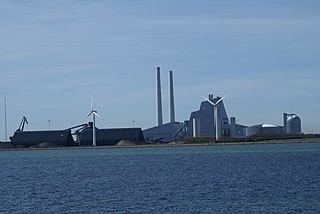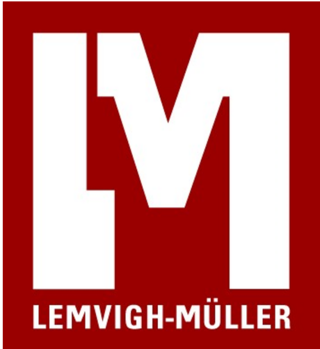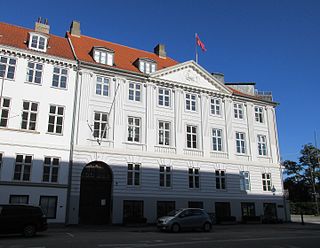
Glud & Marstrand was a manufacturer of metal products based in Copenhagen, Denmark.

Glud & Marstrand was a manufacturer of metal products based in Copenhagen, Denmark.
Glud & Marstrand was founded on 4 August 1879 by plumber Poul Glud (1850–1924) and ironmonger Troels Marstrand (1854–1929) as Glud & Marstrands Fabriker. The company was headquartered at Nordvestvej (now Rantzausgade) in Nørrebro. The site continued to Skolegade (now Struenseegade) on the other side of the block.In 1895, the company was converted into a limited company. [1]
In the 1930s, Glud & Marstrand acquired Carl Lunds Gabrikker on Amager. [2]
In 1978, the company was taken over by Burmeister & Wain under the management of Jan Bonde Nielsen- The following year it went into a controversial merger with Burmeister & Wain A/S and then into liquidation. [1]
In 1981, Glud & Marstrand A/S was revived by the investment company Kirkbi with the production of metal packaging. The company was later merged with a number of other Danish and Swedish companies within the same industry, making Glud & Marstrand Scandinavia's largest and one of Europe's largest suppliers of metal packaging. [1]
In 2005, the company was taken over by the Dutch ABN AMRO Capital. In the same year, the company had 1109 employees and a turnover of DKK 1.66 billion. [1]
In 2011, Glud & Marstrand was acquired by Envases Universales de México, In 2020, its name was changed to Envases Europe A/S.

Glud and Marstrand produced a wide range of metal products for households, inclyding kitchenware, buckets and toys. After the turn of the century, Glud and Marstrand launched their blue enamel kitchenware. Their coffee pot was marketed under the name Madam Blue (Madame Blue). In the 1930s. Glud / Marstrand also launched a production of red and orange enamel products. The production of Madam Blue was discontinued in 1966.
Burmeister & Wain was a large established Danish shipyard and leading diesel engine producer headquartered in Copenhagen, Denmark. Founded by two Danes and an Englishman, its earliest roots stretch back to 1846. Over its 150-year history, it grew successfully into a strong company through the end of the 1960s. In the 1970s, global competitive pressures, particularly from the far east, began to take their toll. In 1980, B&W became MAN B&W Diesel A/S, part of MAN B&W Diesel Group, a subsidiary of the German corporation MAN AG, with operations worldwide. The company still maintains operations at three main sites in Denmark for manufacturing, servicing, and licensing of its two-stroke engines and complete propulsion systems.
MAN Diesel SE was a German manufacturer of large-bore diesel engines for marine propulsion systems and power plant applications. In 2010 it was merged with MAN Turbo to form MAN Diesel & Turbo.
Terma A/S is a Danish defense and aerospace manufacturer for both civilian and military applications, and is owned by the Danish company Thrige Holding A/S. It is Denmark's largest company within the aerospace and the defense industry, employing approximately 1,700 people worldwide.

Le Creuset is a French-Belgian maker of cookware. They are best known for producing enameled cast-iron cookware. The company first manufactured their products in the town of Fresnoy-le-Grand in France in 1925, which are similar in function to a Dutch oven but with T-shaped handles. The Le Creuset Dutch oven is on display in the Smithsonian Institution's National Museum of American History in Washington, D.C. as a part of the recreation of the chef Julia Child's kitchen. It has been widely reported to be her favorite cooking pot, though specialist sources hold that it was the Dutch oven of Le Creuset's less-remembered competitor Descoware that was her real favorite. The company also makes many other types of cookware and bakeware, from fondue-sets to tagines.

Hareskov station is a suburban rail railway station serving the suburb of Hareskovby northwest of Copenhagen, Denmark. The station is located on the Farum radial of Copenhagen's S-train network.

MS Cunard Princess was a cruise ship, previously owned an operated by the Israel-based Mano Maritime. She was built 1975 by the Burmeister & Wain shipyard in Copenhagen, Denmark for Cunard Line as MS Cunard Conquest, but her interior fittings were subsequently installed at the Navali Mechaniche Affini in La Spezia, Italy. Following re-delivery from Navali Mechaniche Affini in 1977 the ship was renamed MS Cunard Princess. In 1995, the ship entered service with StarLauro Cruises, briefly retaining her previous name before being renamed MS Rhapsody. In 2009 she was sold to Mano Maritime and sailed as Golden Iris until 2018. After being laid up for four years at Chalkis Shipyard, Greece. In 2021 was she renamed Gold Club. She was beached at Aliağa, Turkey, for recycling.

The Avedøre Power Station is a combined heat and power station, located in Avedøre, Denmark, just south of Copenhagen, and is owned by Ørsted A/S. Avedøre Power Plant is a high-technology facility and one of the world's most efficient of its kind, being able to utilize as much as 94% of the energy in the fuel and convert 49% of the fuel energy into electricity. Apart from using petroleum (oil) and natural gas, the plant runs on a wide variety of biomass fuels such as straw and wood pellets. The plant consists of two units with a total capacity of 793 MW of electricity and 918 MW of heat. The combination of producing electricity and heat for district heating at the same time is widely used in Denmark and the rest of Scandinavia, due to the need of domestic heating together with the Danish energy companies putting a big effort into optimising the energy plants.

Mitsui Engineering & Shipbuilding is a Japanese heavy industries company. Despite its name, it no longer builds ships and now focuses mainly on production of high-value ship equipments such as engines and automated gantry cranes.

Wilders Plads is a waterfront area located just north of Wilders Kanal, a branch of Christianshavns Kanal, in the north-western corner of the Christianshavn neighbourhood of Copenhagen, Denmark. The area is bounded by Christianshavn Canal to the east and Krøyers Plads to the north.

Refshaleøen is a former industrial site in the harbor of Copenhagen, Denmark, originally on a separate island but now annexed to the larger island of Amager. For more than a hundred years, it was home to the shipyard Burmeister & Wain, which closed in 1996.

The M/1923 helmet was a combat helmet issued to Danish troops during the interwar period and saw service in the Second World War. It was the first helmet to be issued to the Royal Danish Army and Navy. The helmet was produced by the Danish company A/S Glud & Marstrands Fabrikker.

Applebyes Plads is a triangular area located between Langebro Bridge and the southernmost portion of Christianshavn Canal at the southern tip of the Christianshavn neighbourhood in Copenhagen, Denmark. The area takes its name from Peter Applebye, Christian VI's rope maker, who ran his manufactury from the site in the late 18th century, although no buildings remain from that time. The Danish Sugar Factories' building along the waterfront dates from 1912 while the rest of the grounds have undergone residential redevelopment in later years.

Rantzausgade is a street in the Nørrebro district of Copenhagen, Denmark. It runs from Åboulevard in the southeast to Jagtvej in the northeast where its name changes to Borups Allé.

Pandora A/S is a Danish jewelry manufacturer and retailer founded in 1982 by Per Enevoldsen. The company started as a family-run jewelry shop in Copenhagen.

Lemvigh-Müller is the largest wholesaler of steel and technical installations in Denmark, with over 550,000 different products in its range, +1,350 employees, and an annual turnover of 7.980 billion DKK.

Amaliegade 40, formerly known as Toldbodbørsen, is a Neoclassical property located at the corner of Amaliegade and Esplanaden in the Frederiksstaden district of Copenhagen, Denmark. The shipping company D/S Norden was based in the building for more than one hundred years. It was listed in the Danish registry of protected buildings and places in 1918.
Rosendahl Design Group is a family-owned housewares and kitchen utensil company based in Hørsholm, Denmark.

Steffen Peder Anker Heegaard was a Danish industrialist. His company was headquartered in Havnegade in Copenhagen and operated two manufacturing sites in Nørrebro and Frederiksværk. Products included cast ironware, steam engines and agricultural machines. He was a member of the Copenhagen City Council from 1868 to 1885 and president of Industriforeningen from 1871 to 1876.

Titan A/S was a Danish machine factory and iron foundry founded by merger of two older companies in 1897 and based at Tagensvej 86 in the Nørrebro district of Copenhagen, Denmark. It occupied the entire site between the streets Tagensvej, Hermodsgade, Titangade, Sigurdsgade and Rådmandsgade. It merged with Odense-based Thriege in 1965 under the name Thriege-Titan. The merged company is now called T-T Electric and is headquartered in France.

Carl Lund was a Danish industrialist. He was the founder of Carl Lunds Fabrikker. Carl Lunds Vej on Amager in Copenhagen is named after him.